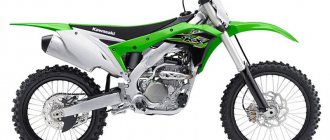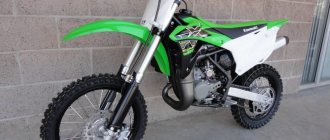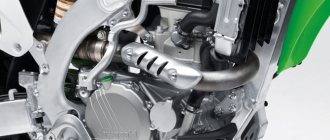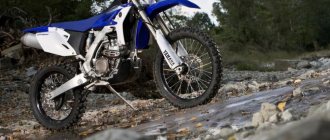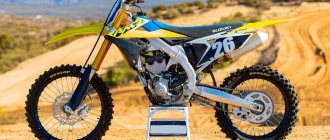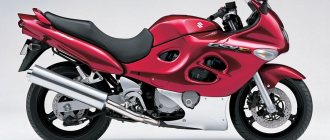| Kawasaki KX250 (KX250A) 1974-1981 | Kawasaki KX250 (KX250B) 1982 | Kawasaki KX250 (KX250C) 1983-1984 |
| Kawasaki KX250 (KX250D) 1985-1986 | Kawasaki KX250 (KX250E) 1987 | Kawasaki KX250 (KX250F) 1988 |
| Kawasaki KX250 (KX250G) 1989 | Kawasaki KX250 (KX250H) 1990-1991 | Kawasaki KX250 (KX250J) 1992-1993 |
| Kawasaki KX250 (KX250K) 1994-1998 | Kawasaki KX250 (KX250L) 1999-2002 | Kawasaki KX250 (KX250M) 2003-2004 |
| Kawasaki KX250 (KX250R) 2005-2008 |
Kawasaki KX250 cross-country motorcycle model
appeared in 1974 and was produced until 2008. The first versions of the motorcycle were produced for the American market, but since 1988 the model has also become available in the markets of Europe and Japan, and since 1990 - in Australia.
A total of 13 generations of the Kawasaki KX250 were produced, but the versions from 1990 are of greatest interest, when the model began to be equipped with an inverted fork. In our review we will consider the model starting from the 9th generation, namely modifications since 1992. Older versions of the motorcycle are very rare and are practically not represented on the Russian market.
The main features of the Kawasaki KX250 are a steel frame, sports adjustable suspension, a powerful 2-stroke liquid-cooled engine with KIPS power valves, disc brakes, a 5-speed gearbox and a 97 kg dry weight.
In 2004, a 4-stroke version of the Kawasaki KX250F appeared, which was designed to replace the 2-stroke KX250. However, despite this, both modifications were sold in parallel until 2008 inclusive, after which the Kawasaki KX 250 was finally discontinued.
The “junior” model is Kawasaki KX 125.
The main competitors of the Kawasaki KX 250 in the class:
- Honda CR 250 (aluminum frame)
- Suzuki RM 250 (steel frame)
- Yamaha YZ 250 (aluminum frame)
Appearance
The car looks typical. However, the Kawasaki KX 250 looks typical now. And this is largely explained by the fact that it was this model that set the trend at one time.
The high fenders, spoked wheels, so familiar today, the narrow curved frame and minimalism in every detail were new then. That's why the bike was produced for about thirty years, which is a huge period even for the end of the twentieth century.
Since its inception, the car has changed many design options. Versions were produced in a salad shade, dark green, and light green.
But green was always present. And this has become, perhaps, a characteristic feature of many Kawasaki bikes. And it is hardly possible to imagine a color that would be better suited for such bikes.
New lower front engine mounts
The Kawasaki KX250's new thin aluminum frame around the lower perimeter of the engine features forged, extruded and cast parts that help improve the bike's handling. Thanks to new lower front engine mounts and the replacement of through-bolts with studs at the front of the crankcase, overall frame rigidity has been revised and the frame's ability to absorb bumps has been improved. The center of gravity and key dimensions, such as the position of the drive sprocket and the location of the rear engine mounting axle, have been carefully tuned to ensure the best transfer of torque from the drive wheel to the frame.
Comfort
The car is convenient for many reasons. High ground clearance, medium-height handlebars, light weight... However, it is not correct to talk about the comfort of this Kawasaki motorcycle outside the context of its purpose. There is no need for such a thing in the city.
On a country road, too. But off-road, especially dry and especially in motocross competitions, this is an indispensable device.
Of course, road motorcycles will be more convenient in civilized conditions. But where there are hills, potholes and mud all around, this technique is perfect.
Lightweight and mobile, the KX 250 can easily outpace most of today's enduro bikes in dry weather off-road. When it’s damp and slippery, the light weight and relatively low power will make themselves felt.
Launch control system
The Kawasaki KX250's launch control system is a major benefit for riders who want to get into the first turn ahead of their competitors. Push-button activation changes the ignition operation in first and second gear, helping to increase traction on slippery surfaces such as hard launch pads. As soon as the rider shifts into third gear, the ignition switches into combat mode and full power is restored. CHASSIS
Dimensions and weight
The machine meets the technical specifications in terms of dimensions. Thanks to this combination, it is ultimately possible to achieve the lightness required for “flights” from springboards and other properties critical for the cross-country model.
The dimensions are as follows:
- height – 1265 mm;
- width – 840 mm;
- length – 2185 mm;
- wheelbase – 1480 mm;
- seat height – 950 mm;
- ground clearance - 380 mm;
- curb weight – 103 kg;
- Tank capacity – 8.5 l.
It is worth saying that the tank volume here is small relative to fuel consumption. But this is normal for cross-country equipment. These vehicles are more like sports equipment and are not intended for everyday driving. Unless this is moving somewhere in the countryside and exclusively on country roads.
Kawasaki KX250 2021
When you first see the new model, you might say, “Hey, the only difference between the new KX250 and the old one is the green plates.” This is wrong. Not at all like that. Kawasaki's engineering team seemed to have clear goals when upgrading the KX250's engine to be more powerful, faster and lighter. The suspension was not left unattended either - the motorcycle received a new KYB shock absorber and a new fork with double springs, also from KYB.
On the 2021 Kawasaki KX250, you won't see the treasured button on the right side of the handlebar that allows you to start the engine. There is no electric starter, and while just a few years ago we all thought it was a luxury, an electric starter is quickly becoming an expected feature on modern motocross bikes. Kawasaki also stays true to the plug-in card method for engine control, while the rest of the manufacturers already use some kind of buttons on the handlebar... There are also no changes to the frame, plastics, transmission, swingarm, wheels, footpegs, handlebars or control levers.
Kawasaki KX250 New engine - changes
Let's start with the biggest difference between the 2019 and 2021 KX250 motorcycles: the engine. The main change is a larger diameter piston with a shorter stroke. This change alone allows any engine to have a faster, sharper character and more power. But Kawasaki didn't stop there. The cylinder has a new head with valve actuators using a special "pin", technology borrowed from Kawasaki's road sports bikes.
New Kawasaki KX250 engine
Although this system adds a little weight to the overall bike, it reduces the mass of moving parts when operating the valves, making them faster and less sluggish in motion. This allows for a higher maximum rpm limit and more aggressive cam profiles. Thanks to the use of a new drive system, it was possible to increase the diameter of the valves and their holes, which allows them to pass more air-fuel mixture and exhaust gases.
The piston has a shorter skirt and internal box-style reinforcement, making it stronger and lighter than the previous piston. The compression ratio has also increased from 13.4:1 to 14.2:1. The final change to the engine is new low friction crankshaft journal bearings.
The intake tract is straighter thanks to a redesigned air filter housing, and its overall length is shorter. The throttle valve diameter has increased from 43 mm to 44 mm. The final change to the powertrain is a shorter exhaust system, again to increase power.
Specifications
If you want high speed on the highway, you should pay attention to a sportbike. And this technique is intended primarily for overcoming obstacles on rough terrain. This explains the properties of the engine, chassis and transmission. They are aimed only at these purposes.
| Motor type | in-line, 1 cylinder, 2 stroke |
| Power | 54.6 hp |
| Torque | 49 Nm |
| Maximum speed | 230 km/h |
| Acceleration to 100 | 3.5 s |
| Fuel consumption per hundred | 3 l |
| Drive unit | chain |
| Transmission | five-speed |
| Frame | half-duplex steel |
| Rear suspension | pendulum, monoshock absorber, stroke 310 mm |
| Front suspension | inverted fork, 300 mm travel |
| Rear brakes | 1 disc, 215 mm, 1-piston caliper |
| Front brakes | 1 disc, 225 mm, 2-piston caliper |
The suspension travel is enormous, as it should ideally be for a representative of the class. Combined with impeccable ground clearance, this makes the bike the best option among older cross-country machines. However, today there are many options that will surpass this motorcycle. Objectively.
Reviews
Reviews about Kawasaki KX 250:
Expand Collapse
I had a KX250...I took it by mistake (I wanted a bike for cross-country rides). After three or four trips I realized that this is a purely sports equipment - its place is in cross-country, and not for walking, then I bought a KLX250... which I’m glad about)))
minus of the KX250 is that it is a 2-stroke engine - the short life of the forced engine, oil needs to be added to the gasoline, and in general, with such fuel consumption, you ride around the canister........and I also got a kicker, something is wrong and it’s a problem to start (((
The most impressive thing about the KX250 motorcycle is the engine. In the lower and mid-range the engine delivers strong but smooth and controlled power, and the KX launches out of corners with grace. The top rev range is also strong, although Kawasaki's may not be the strongest compared to rival brands. We found that the KX performs better with short shifts and keeping the engine speed at mid-range. If you're looking for a 250 class motocross bike that has strong, usable, controllable power, buy the KX and it won't disappoint in that department.
We also left unchanged the fuel trim, which we changed in October by lowering the needle one notch. We never once had the feeling that something else needed to be changed in the carburetor.
During our testing, the KX's transmission performed well (we never had any shifting problems after our very first test ride) and we found the gear ratios to be very well matched to the engine's powerband. However, given that the KX engine has such a strong lower and mid-range distribution, we would prefer to install a rear sprocket on the motorcycle for high-speed tracks, which has one less tooth. Unfortunately, we did not have time to test the car with a different sprocket, but we believe that such a small modification will allow you to go a little longer in each gear before shifting.
The bike is stable in a straight line and has exceptional cornering performance, turning into corners with precision and maintaining the driver's intended line perfectly. The KX model is especially impressive when passing through ruts, ruts, and potholes, although when passing smooth corners the motorcycle sometimes tends to go over a wider radius.
The KX model turned out to be very reliable - we had no problems with the mechanics, and our maintenance was limited only to changing the oil and cleaning the air filter. The green plastic also holds up well despite a few drops, and the fit and finish on the bike is good. When we returned our bike to the Kawasaki dealer after several months of testing, it looked almost like new, except that the paint had rubbed off on the frame tubes above the pegs. But this happened with every motocross bike we tested that had a painted frame.
Considering all the strengths of this machine, we were not surprised that the 2005 KX250 motorcycle was the best in comparative tests of 250 cc class models. cm, which were carried out by at least two major motorcycle magazines.
This bike doesn't have a single major/serious flaw, and the engine and handling are either class leading or approaching class leading. In the US, the recommended retail price for the 2005 model year KX250 motorcycle is $5,999, which is quite reasonable.
What do the owners say?
Judging by the reviews, it is now possible to purchase such a motorcycle in good condition for little money. Around 100 thousand Russian rubles - that’s how much such a bike costs. Yes, you can’t get a new one now, but you can actually buy a used one in good condition. This is confirmed by both video and photos.
As for maintenance, difficulties are possible. The fact is that today it is no longer so easy to get spare parts for this bike, although owners have different opinions on this matter. If desired, such a motorcycle can be used.
But it is important to understand that even good-looking equipment may have suffered serious damage at some point. And such damage is sometimes invisible during quiet driving, and the owner may not even know about it.
According to the description of many, this model handles well on sharp turns. Almost every review says this. However, today this is not the most maneuverable option in the class. And if anyone should take such equipment, it would be first and foremost a connoisseur of timeless classics.
In conclusion, the Kawasaki KX 250 is a great bike for racing and stunts. But only for motocross. Otherwise, this machine is not suitable. Also, such equipment will be a help for a villager who periodically needs to get somewhere without luggage.
Brief history of the model
- 1974 - start of production and sales. First generation
.
Model
: Kawasaki KX250 (North America).
Factory designation:
KX250-A1.
- 1975 - no significant changes.
Model
: Kawasaki KX250 (North America).
Factory designation:
KX250-A2.
- 1976 - no significant changes.
Model
: Kawasaki KX250 (North America).
Factory designation:
KX250-A3.
- 1978 - no significant changes.
Model
: Kawasaki KX250 (North America).
Factory designation:
KX250-A4.
- 1979 - no significant changes.
Model
: Kawasaki KX250 (North America).
Factory designation:
KX250-A5.
- 1980 - no significant changes.
Model
: Kawasaki KX250 (North America).
Factory designation:
KX250-A6.
- 1981 - no significant changes.
Model
: Kawasaki KX250 (North America).
Factory designation:
KX250-A7.
- 1982 - restyling of the model. Second generation
.
Model
: Kawasaki KX250 (North America).
Factory designation:
KX250-B1.
- 1983 - restyling of the model. Third generation
.
Model
: Kawasaki KX250 (North America).
Factory designation:
KX250-C1.
- 1984 - no significant changes.
Model
: Kawasaki KX250 (North America).
Factory designation:
KX250-C2.
- 1985 - restyling of the model. Fourth generation
.
Model
: Kawasaki KX250 (North America).
Factory designation:
KX250-D1.
- 1986 - no significant changes.
Model
: Kawasaki KX250 (North America).
Factory designation:
KX250-D2.
- 1987 - restyling of the model. Fifth generation.
Model
: Kawasaki KX250 (North America).
Factory designation:
KX250-E1.
- 1988 - restyling of the model. Sixth generation.
Model
: Kawasaki KX250 (North America, Europe, Japan).
Factory designation:
KX250-F1.
- 1989 - restyling of the model. Seventh generation.
Model
: Kawasaki KX250 (North America, Europe, Japan).
Factory designation:
KX250-G1.
- 1990 - restyling of the model. Eighth generation.
Model
: Kawasaki KX250 (North America, Europe, Japan, Australia).
Factory designation:
KX250-H1.
- 1991 - no significant changes.
Model
: Kawasaki KX250 (North America, Europe, Japan, Australia).
Factory designation:
KX250-H2.
- 1992 - restyling of the model. Ninth generation
.
Model
: Kawasaki KX250 (North America, Europe, Japan, Australia).
Factory designation:
KX250-J1.
- 1993 - no significant changes.
Model
: Kawasaki KX250 (North America, Europe, Japan, Australia).
Factory designation:
KX250-J2.
- 1994 - restyling of the model. Tenth generation
.
Model
: Kawasaki KX250 (North America, Europe, Japan, Australia).
Factory designation:
KX250-K1.
- 1995 - no significant changes.
Model
: Kawasaki KX250 (North America, Europe, Japan, Australia).
Factory designation:
KX250-K2.
- 1996 - no significant changes.
Model
: Kawasaki KX250 (North America, Europe, Japan, Australia).
Factory designation:
KX250-K3.
- 1997 - no significant changes.
Model
: Kawasaki KX250 (North America, Europe, Japan, Australia).
Factory designation:
KX250-K4.
- 1998 - no significant changes.
Model
: Kawasaki KX250 (North America, Europe, Japan, Australia).
Factory designation:
KX250-K5.
- 1999 - restyling of the model. Eleventh generation
.
Model
: Kawasaki KX250 (North America, Europe, Japan, Australia).
Factory designation:
KX250-L1.
- 2000 - no significant changes.
Model
: Kawasaki KX250 (North America, Europe, Japan, Australia).
Factory designation:
KX250-L2.
- 2001 - no significant changes.
Model
: Kawasaki KX250 (North America, Europe, Japan, Australia).
Factory designation:
KX250-L3.
- 2002 - no significant changes.
Model
: Kawasaki KX250 (North America, Europe, Japan, Australia).
Factory designation:
KX250-L4.
- 2003 - restyling of the model. Twelfth generation
.
Model
: Kawasaki KX250 (North America, Europe, Japan, Australia).
Factory designation:
KX250-M1.
- 2004 - no significant changes.
Model
: Kawasaki KX250 (North America, Europe, Japan, Australia).
Factory designation:
KX250-M2.
- 2005 - restyling of the model. Thirteenth generation
.
Model
: Kawasaki KX250 (North America, Europe, Japan, Australia).
Factory designation:
KX250-R1.
- 2006 - no significant changes.
Model
: Kawasaki KX250 (North America, Europe, Japan, Australia).
Factory designation:
KX250-R6F.
- 2007 - no significant changes.
Model
: Kawasaki KX250 (North America, Europe, Japan, Australia).
Factory designation:
KX250-R7F.
- 2008 is the last year of production.
Model
: Kawasaki KX250 (Europe, Japan, Australia).
Factory designation:
KX250-R8F.
Competitors
Kawasaki made the competition sweat by being the first to release one of the best models in cross-country racing, but they presented their answers.
Yamaha YZ 250.
Suzuki RM 250.
Honda CR250R.
In the same year, the Yamaha YZ 250 appeared, followed two years later by the Suzuki RM 250. The Honda CR250R model appeared, although earlier than the Kawasaki, but it took its rightful place only in 1997 .
Moreover, all except Suzuki get an aluminum frame . Perhaps this is why, when designing a successor model, Kawasaki enters into an agreement with them, which results in the clone brothers KX250F , from Kawasaki, and the RM-Z250 from Suzuki.
Peculiarities
The design of the motorcycle is based on a half-duplex steel frame.
- The engine has a pronounced cross-country character , not very suitable for simple rides.
- The rural type is a simple bike for traveling anywhere, provided that the pilot does not need to carry luggage and will not go to special roads.
- Light weight - less than 100 kg dry weight and 103 kg curb weight.
- Oil consumption - a properly tuned engine does not consume oil, but according to the conditions of use of 2t, you will have to add MORE than a liter at EACH refueling.
- The gearbox is set up clearly, the gear ratios are well balanced.
- Durable steel frame can withstand falls.
- A classic is an archaic bike for connoisseurs, those who believe that technology should remain technology, and not bend to the current fashion.
